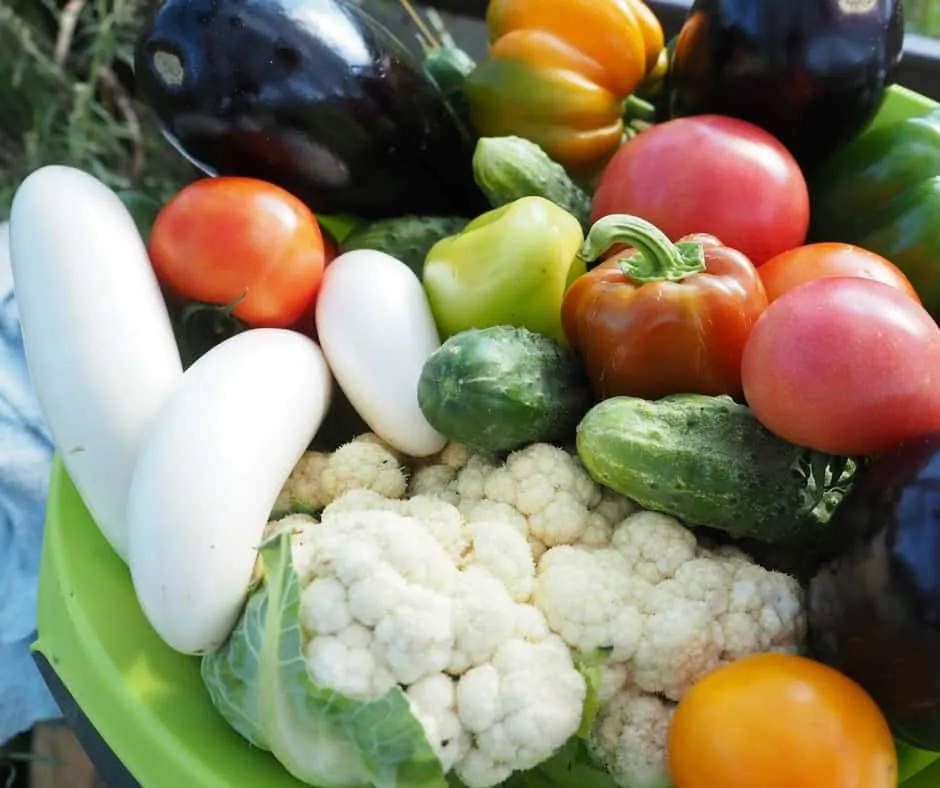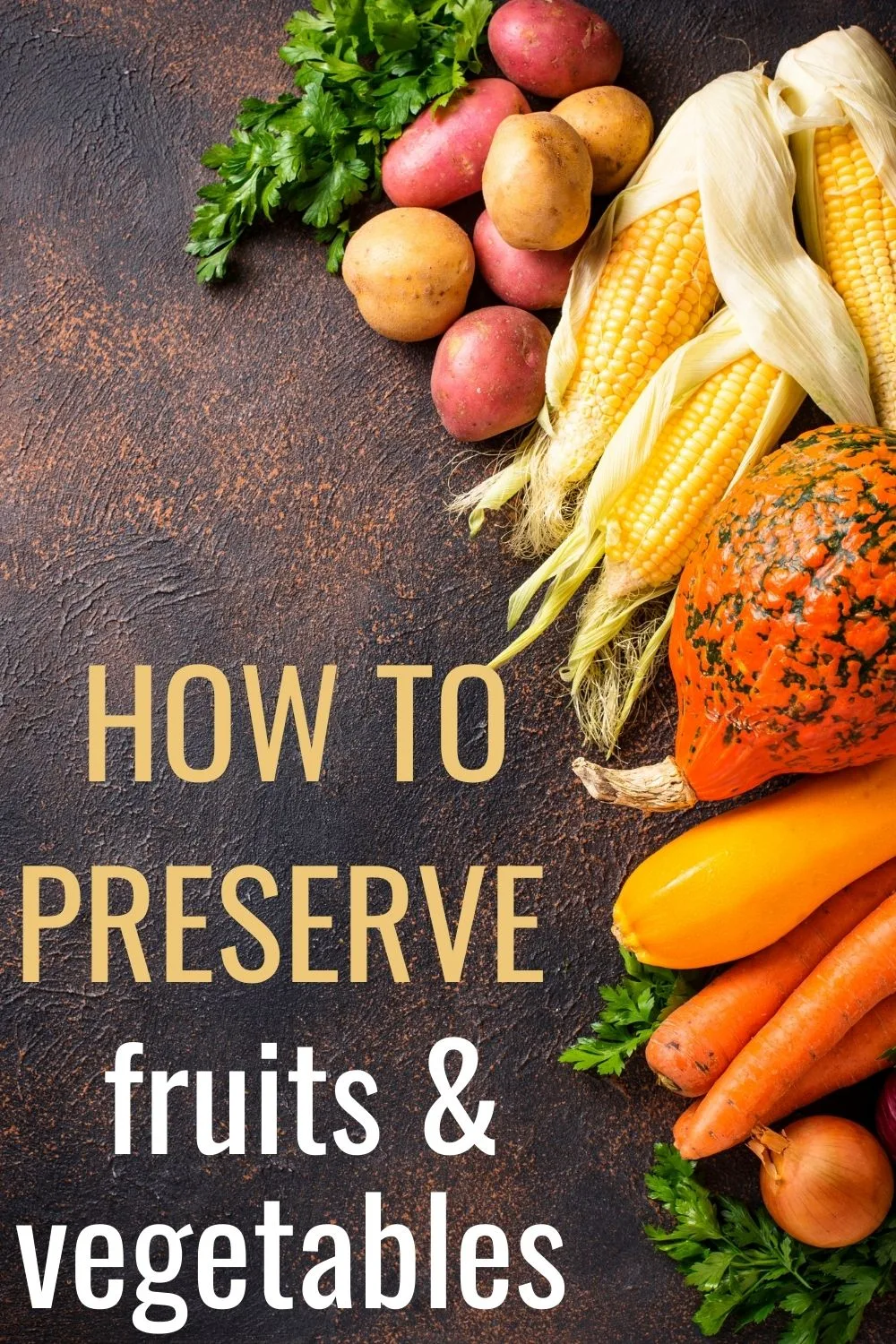It’s the middle of the summer, and the garden is producing loads of fruits and vegetables. Are you taking advantage of this and preserving some for later in the year when fresh food is hard to come by? You need to know how to preserve fruits and vegetables so you can stretch your harvest for months to come.

It’s so sad that today fewer people are preserving their harvest. We’ve gotten used to fast everything and it’s a shame.
Farmer’s markets are full of goodies. Neighbors are giving away extra produce because they are sick and tired of eating the same veggies over and over. But you are smarter than that, right? Here are 5 ways to preserve your harvest.
How To Preserve Fruits And Vegetables
1. Freezing garden harvest
Freezing garden vegetables and fruits is my favorite way of preserving the harvest. It’s fast and it preserves the nutrients the best.
The only disadvantage to freezing food is that you’re limited by the amount of room you have in your freezer. Of course, if you’re serious about preserving your hard-worked harvest, you might just invest in a second freezer, as many of us do.
Remember to label all your frozen food containers, so you know how long it’s been in the freezer and be able to pull the right container when you’re ready to cook. You’ll save yourself the trouble of needing to learn how to make strawberry soup instead of tomato soup (ask me how I know that!)
You can freeze produce straight from the garden to use in dishes later, or you can actually make freezer-friendly meals and freeze those for easy dinners during the holidays or other busy times.
Freezing is also a great way to preserve summer fruits that only last a short time once picked: blueberries, raspberries, blackberries, strawberries, etc.
Best freezer storage containers
50 Food Containers with leakproof lids – 25 oz | Microwave & Freezer safe | Plastic Meal Storage by Prep Naturals Reditainer Extreme Freeze Deli Food Containers with Lids, 32-Ounce, 24-Pack
Reditainer Extreme Freeze Deli Food Containers with Lids, 32-Ounce, 24-Pack Arrow Home Products 04365 30 Piece Freezer Storage Container Set
Arrow Home Products 04365 30 Piece Freezer Storage Container Set
Can you freeze all vegetables?
Virtually all your vegetables can be frozen; the exceptions would be cucumbers and lettuce as frozen temperatures destroy these plants. And some vegetables such as peas seem to be made for freezing.
How to freeze brassicas
All brassicas freeze well, simply prepare the vegetables as you would need them for the table, then blanch in boiling water for about a minute (30 seconds for broccoli), and plunge into ice-cold water to stop them cooking. Drain and pat dry, freeze on trays, and bag up once frozen.
Can you store legumes in the freezer?
- Beans and peas freeze well, simply pod peas and broad beans, rinse and blanch for just under a minute, chill in cold water and tray up to freeze.
- French beans need little work, top and tail, rinse and blanch and freeze in the usual way.
- Peas take no time at all: maybe thirty seconds in the boiling water.
- Runner beans will need slicing and consequently, they will tend to lose small beans in the hot water so blanch runners last when batch freezing. Once blanched, chill, tray up and freeze in the normal way. Some people will tell you that runner beans do not freeze well; yes, some beans may go a bit tough but if you choose the right variety, such as Polestar, and pick when young, runner beans make great freezing vegetables.
How about root vegetables? Can you freeze them?
Potatoes do not freeze unless you prepare a mash and freeze as mash potato portions. You can use your damaged spuds to cook down this way.
Carrots freeze well as do parsnips if you need to. However, parsnips are better left in the ground over winter and we would only freeze if there were vegetables left in the ground in the spring.
We don’t often freeze beets, as they too will stay in the ground until needed and as yet we have never had too much. But if you have more than you can handle, and your ground freezes solid in the winter, boil, peel, and freeze: they are delicious after thawing out.
Should you freeze alliums?
You will not need to freeze onions and garlic as they store well in dry storage, but if you are having problems with softening onions, particularly at the end of the winter, then you may be tempted to freeze them. The only way to successfully freeze them is to dice them into bags, but no matter how thick the bag, the onion smell seems to take over the freezer.
Or, caramelize them and freeze them after. We tried this last year and absolutely LOVED being able to pull a container of caramelized onions in the evening and use it the next day without all the fuss of cooking it.
Leeks will freeze, but they should be fine left in the ground over winter unless the temperature has been up and down. If so, they might try and flower and you will need to pull them. We would prefer to use excess leeks as onions, or perhaps make braised leeks or potato and leek soup rather than freezing them sliced.
Can you freeze cucurbits?
Your pumpkins, squash, and courgettes can be some of the most rewarding parts of vegetable garden gardening as they crop so well, and yes they also freeze well too. Just prepare as if you were going to cook with them, blanch for half a minute, plunge into cold water, drain, dry, and freeze on trays.
But probably the best way to freeze these vegetables would be to turn them into soups and bag them into portions. Squash and pesto soup is a favorite, and for something a bit different why not try Thai pumpkin soup.
Learn more about how to freeze zucchini.
Freezing other vegetables
Spinach is a good freezer crop although perpetual spinach is usually available fresh. But throughout fall and early winter, it can get a bit tired. If you plan ahead you can freeze quite a lot in the summer.
To freeze spinach pull off the stalks, roughly chop and cook in boiling water until well wilted, then chill in cold water and roll into balls squeezing as much water out as you can. Then simply tray up and freeze. You’ll be amazed at how little space is needed to freeze what seemed like a mass of spinach.
Tomato is one of our most important crops as we make a lot of pasta sauces, chilies, and curries and would get through a lot of canned tomatoes in the winter without a freezer.
We grow a lot of tomatoes, and while we love eating them fresh, a lot goes in the freezer for the winter. The Money Maker variety freeze well and make a good sauce. Another good one is San Marzano, supposedly the chef’s choice for tomato sauces.
Freezing tomatoes is easy, just wash and dry them, put them on a tray, and freeze. Then bag up to store. Seems odd but when you defrost them they are just right for sauce making.
Learn more about how to freeze tomatoes.
2. Canning garden harvest
While it takes a bit longer to preserve food this way, canning is one of the most versatile ways to preserve food. Canning works for tomatoes, beans, jellies, pie fillings, and so much more!!!
Once canned, your food will store for quite a long time in your basement, cooler, or pantry shelves. No need for electricity: they can be eaten right out of the jar if needed.
Here are some slow cooker recipes to use some of your canned foods.
Canning accessories
Ball Dissolvable Labels, Set of 60 Granite Ware 0718-1 Enamel-on-Steel Canning Kit, 9-Piece
Granite Ware 0718-1 Enamel-on-Steel Canning Kit, 9-Piece Bellemain 6 Piece Canning Tool Set – Vinyl Coated Stainless Steel
Bellemain 6 Piece Canning Tool Set – Vinyl Coated Stainless Steel
3. Dehydrating food for long term storage
Dehydrating food is a great solution if you don’t have a lot of space, as your produce will shrink with dehydration.
There are several methods to dehydrate your food, and not all methods work for everything. For example, you can dry herbs in a shaded breezy place (like a garage or carport).
You can also use your oven on a low setting to dry out foods. Or, for the fastest and most efficient way use a dehydrator.
If you’re not familiar with dehydrated foods, try some simple foods first: apple slices, berries, banana and kale chips, and even dried veggies to use in soups.
Need a dehydrator? These are great!
Hamilton Beach 32100A Food Dehydrator, Gray NutriChef Food Dehydrator Machine
NutriChef Food Dehydrator Machine 
4. Pickling to preserve food
Does pickling preserve food? Absolutely! And it’s delicious too!
The most popular picked food is cucumbers, but there are so many more picked foods that are delicious! Try pickled zucchini, beets, cauliflower, carrots, and cabbage, just to begin with.
Pickling food is easy: cover your desired picking veggie with a solution made of salt, sugar, water, and various pickling spices.
Pickled vegetables make a great addition to sandwiches and salads, and are a great side dish for many meals throughout the year.
Mrs. Wages Pickling Lime (1-Pound Resealable Bag) DIY Pickling: Step-By-Step Recipes for Fermented, Fresh, and Quick Pickles
DIY Pickling: Step-By-Step Recipes for Fermented, Fresh, and Quick Pickles Ball Pickle Crisp Granules 5.5 oz (Pack of 1)
Ball Pickle Crisp Granules 5.5 oz (Pack of 1)
5. Cold store harvest to keep it fresh
Many of the garden vegetables and fruits can be stored in a cool place for a long time. Things like root vegetables, apples, and cabbages store well in a dry, cool, and dark place.
Remember the root cellars? That’s what they were made for. We keep some of these in our garage, but a basement could work too.
As you can see, you have options! Don’t let your harvest go bad: preserve it for later use now that you know how to preserve fruits and vegetables. Do you use any other methods? Please share in the comments.













Backyard Vegetable Garden Ideas
Wednesday 17th of August 2022
[…] How To Preserve Fruits And Vegetables […]
Chicken Corn Chowder: A Recipe I Remember From My Grandmother
Thursday 31st of December 2020
[…] up on a farm we often had fresh vegetables during the warm months. Fall was canning season, so we could extend the shelf life of those vegetables. One of the things I remember was we […]
Sustainable Living - A Step By Step Guide To A Simpler, More Fulfilling Life
Tuesday 29th of September 2020
[…] are many different opportunities to preserve your produce before it goes bad. For example, if you buy an abundance of apples and can’t eat them all […]
Backyard Organic Vegetable Garden | Backyard Garden Lover
Tuesday 21st of November 2017
[…] There’s no denying that vegetables from your own garden are much better than anything you can buy from the grocery store. Organic vegetables are expensive to buy, so why not grow your own backyard organic vegetable garden that can give you delicious veggies for the entire year? […]
Why Eat Locally Grown Food | Backyard Garden Lover
Thursday 16th of November 2017
[…] year when your farmers market is closed and your garden doesn’t produce much. I’m talking about preserving your fresh local food of course. There are all sorts of different things you can do to preserve food to use down the […]